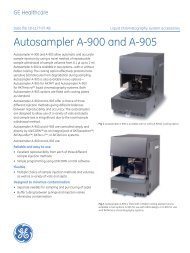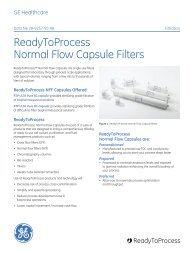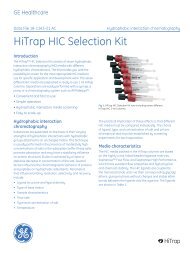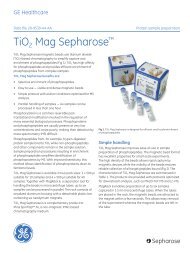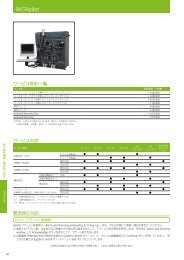[PDF] Ni Sepharose 6 Fast Flow
[PDF] Ni Sepharose 6 Fast Flow
[PDF] Ni Sepharose 6 Fast Flow
You also want an ePaper? Increase the reach of your titles
YUMPU automatically turns print PDFs into web optimized ePapers that Google loves.
Column:<br />
HisTrap FF 1 ml<br />
Sample: Histidine-tagged Maltose Binding Protein in E. coli extract<br />
Binding buffer: 20 mM sodium phosphate, 25 mM imidazole, 500 mM NaCl, pH 7.4<br />
Elution buffer: 20 mM sodium phosphate, 500 mM imidazole, 500 mM NaCl, pH 7.4<br />
<strong>Flow</strong> rate: 1 ml/min<br />
M r<br />
97000<br />
66000<br />
45000<br />
30000<br />
Lanes<br />
20100<br />
1. LMW markers (LMW-SDS Marker Kit)<br />
2. <strong>Flow</strong>through<br />
14400<br />
3. Eluted pool<br />
4. Start material<br />
Fig 2. Purification of MBP-(histidine) 6<br />
on HisTrap FF 1 ml, and SDS-PAGE<br />
analysis under nonreducing conditions (ExcelGel SDS Gradient 8–18).<br />
Repeated purification without <strong>Ni</strong> 2+ recharging<br />
Reproducibility in terms of purity, selectivity, and recovery over<br />
a number of repeated runs without stripping, cleaning, or <strong>Ni</strong> 2+<br />
recharging was investigated. Six repeated purifications of<br />
A)<br />
MBP-(histidine) 6<br />
and five repeated purifications of GFP-<br />
(histidine) 6<br />
, from E. coli extract, were run on HisTrap FF 1 ml<br />
and HisPrep FF 16/10 columns, respectively. The SDS-PAGE<br />
analysis and chromatograms (Figs 3 and 4) showed good<br />
reproducibility. The purity of the target protein did not<br />
change and no variation in recovery was observed.<br />
Furthermore, <strong>Ni</strong> 2+ leakage was low in all cases (Table 6).<br />
Note: The number of reproducible runs without <strong>Ni</strong> 2+<br />
recharging, cleaning, etc. will depend on the sample<br />
and protein used.<br />
B)<br />
Column:<br />
HisTrap FF 1 ml<br />
Sample: Histidine-tagged Maltose Binding Protein in E. coli extract<br />
Binding buffer: 20 mM sodium phosphate, 5 mM imidazole, 500 mM NaCl, pH 7.4<br />
Elution buffer: 20 mM sodium phosphate, 5-200 mM imidazole, 500 mM NaCl, pH<br />
7.4 (linear gradient)<br />
<strong>Flow</strong> rate: 1 ml/min<br />
97000<br />
66000<br />
45000<br />
30000<br />
20100<br />
14400<br />
M r<br />
1 2 3 4<br />
1 2 3 4 5 6 7<br />
Lanes<br />
1. LMW markers (LMW-SDS Marker Kit)<br />
2. Run 1<br />
3. Run 2<br />
4. Run 3<br />
5. Run 4<br />
6. Run 5<br />
7. Run 6<br />
Fig 3. Six repeated purifications of MBP-(histidine) 6<br />
from E. coli extract on<br />
<strong>Ni</strong> <strong>Sepharose</strong> 6 <strong>Fast</strong> <strong>Flow</strong> without stripping, cleaning, or <strong>Ni</strong> 2+ recharging.<br />
Analysis by SDS-PAGE (nonreducing conditions; ExcelGel SDS Gradient 8–18)<br />
of the eluted pools shows excellent reproducibility.<br />
Table 6. Summary of results from the six repeated purification runs on<br />
HisTrap FF 1 ml<br />
Amount eluted Yield Molar ratio<br />
Run protein (mg) (%) <strong>Ni</strong> 2+ /protein<br />
1 7.5 88 0.14<br />
2 7.4 87 0.11<br />
3 7.4 87 0.08<br />
4 7.2 85 0.07<br />
5 7.5 88 0.07<br />
6 7.5 88 0.06<br />
Column: HisPrep FF 16/10<br />
Sample:<br />
GFP-(histidine) 6<br />
in E.coli lysate<br />
Sample volume: 20 ml, ~140 mg GFP-(histidine) 6<br />
Binding and<br />
wash buffer: 20 mM sodium phosphate, 500 mM NaCl, 5 mM imidazole, pH 7.4<br />
Elution buffer: 20 mM sodium phosphate, 500 mM sodium chloride,<br />
250 mM imidazole, pH 7.4<br />
<strong>Flow</strong> rate: 5 ml/min (150 cm/h)<br />
Gradient: 0 to 100 % elution buffer in 400 ml (20 CV)<br />
Detection: 490 nm<br />
System: ÄKTAexplorer 100<br />
%<br />
Elution<br />
A 490 nm<br />
buffer<br />
mAU<br />
100<br />
1400<br />
1200<br />
1000<br />
800<br />
600<br />
400<br />
200<br />
0<br />
0 200 400 600 800 ml<br />
M r<br />
97000<br />
66000<br />
45000<br />
30000<br />
20100<br />
14400<br />
Lanes<br />
1. LMW markers (LMW-SDS Marker Kit)<br />
1 2 3 4 5 6 7 8 9 10 11 12 13 14<br />
2. Start material GFP-(histidine) 6<br />
in E.coli lysate, diluted 5X<br />
3. Start material GFP-(histidine) 6<br />
in E.coli lysate, diluted 10X<br />
4. <strong>Flow</strong>through, HisPrep 16/10 FF (first-generation column)<br />
5. Eluted pool, HisPrep 16/10 FF (first-generation column)<br />
6. <strong>Flow</strong>through, HisPrep 16/10 FF, run 1<br />
7. Eluted pool, HisPrep 16/10 FF, run 1<br />
8. <strong>Flow</strong>through, HisPrep 16/10 FF, run 2<br />
9. Eluted pool, HisPrep 16/10 FF, run 2<br />
10. <strong>Flow</strong>through, HisPrep 16/10 FF, run 3<br />
11. Eluted pool, HisPrep 16/10 FF, run 3<br />
12. Eluted pool, HisPrep 16/10 FF, run 4<br />
13. Eluted pool, HisPrep 16/10 FF, run 5<br />
14. LMW markers (LMW-SDS Marker Kit)<br />
Fig 4. Purification of GFP-(histidine) 6<br />
in E. coli extract using HisPrep FF 16/10<br />
columns. A) Five repetitive purifications on the same HisPrep FF 16/10 column.<br />
B) Analysis by SDS-PAGE (under reducing conditions; ExcelGel SDS Gradient<br />
8–18), stained with Coomassie, shows high reproducibility.<br />
80<br />
60<br />
40<br />
20<br />
0<br />
4 11-0008-86 AE


![[PDF] Ni Sepharose 6 Fast Flow](https://img.yumpu.com/21495109/4/500x640/pdf-ni-sepharose-6-fast-flow.jpg)
![[PDF] マニュアル GradiFrac](https://img.yumpu.com/22037825/1/190x253/pdf-gradifrac.jpg?quality=85)
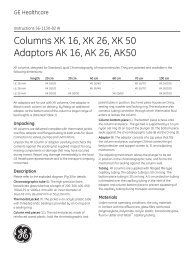
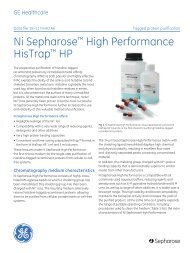
![[PDF] Sample preparation for analysis of protein, peptides and ...](https://img.yumpu.com/21549715/1/190x257/pdf-sample-preparation-for-analysis-of-protein-peptides-and-.jpg?quality=85)
![[PDF] Data File: rProtein A Sepharose Fast Flow](https://img.yumpu.com/21549316/1/190x253/pdf-data-file-rprotein-a-sepharose-fast-flow.jpg?quality=85)
![[PDF] MBP-tagged protein purification](https://img.yumpu.com/21548507/1/184x260/pdf-mbp-tagged-protein-purification.jpg?quality=85)
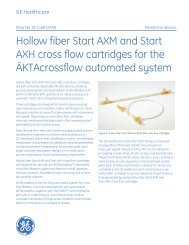
![[PDF] AKTA ready system Data file](https://img.yumpu.com/21540925/1/190x253/pdf-akta-ready-system-data-file.jpg?quality=85)
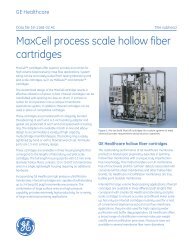
![[PDF] Data File - rProtein A/Protein G GraviTrap](https://img.yumpu.com/21539052/1/190x253/pdf-data-file-rprotein-a-protein-g-gravitrap.jpg?quality=85)
